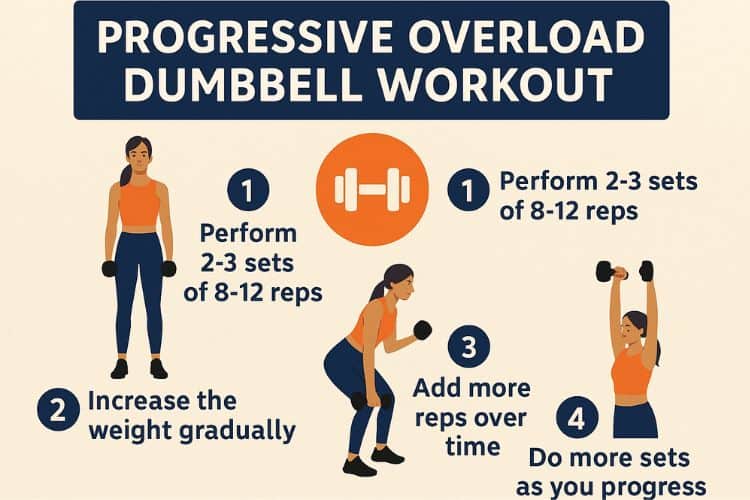Sign up for workout ideas, training advice, reviews of the latest gear and more.






What is a Progressive overload dumbbell workout plan Progressive overload is a simple yet powerful fitness principle that drives muscle growth, strength gains, and endurance improvements. It means gradually increasing the challenge placed on your muscles over time — by adding more weight, increasing repetitions, improving form, or reducing rest time.
For women who train with dumbbells, progressive overload is the key to getting stronger, leaner, and more sculpted. Without it, your muscles adapt and plateau, halting progress. With it, your body constantly adapts to new challenges, resulting in continuous improvement.
Many women fear lifting heavier weights, thinking it will make them bulky. The truth is that progressive overload helps women build toned, defined muscles while burning more calories and improving metabolism.
Here’s what makes progressive overload essential:
Your body adapts to stress. When you lift a weight that challenges your muscles, microscopic fibers tear. As they repair, they become stronger and more resilient. Progressive overload takes advantage of this by continually increasing the demand placed on muscles.
Here are the main ways to apply it in your dumbbell workouts:
Once an exercise feels too easy, increase the dumbbell weight slightly (2–5 lbs at a time). Small, consistent jumps are safer and more sustainable.
If you’re not ready to increase weight, try performing extra reps (e.g., from 10 to 12) or add an additional set to increase total volume.
Controlling your movement speed increases time under tension — a powerful way to boost muscle stimulation without adding weight.
Cutting rest between sets (e.g., from 60 seconds to 45) makes your muscles work harder and builds endurance.
Better form ensures the right muscles are targeted efficiently, maximizing the impact of each rep.
Progressive overload dumbbell workouts deliver both aesthetic and functional benefits. Below are the most important ones:
Progressive overload ensures your muscles never stagnate. Each week you become stronger, lifting heavier and performing better.
By challenging your muscles with consistent overload, you create the definition in arms, glutes, shoulders, and abs that most women desire.
Strength training through progressive overload boosts muscle mass — which in turn burns calories even when you’re resting.
Your muscles and cardiovascular system adapt to higher workloads, improving stamina for both workouts and daily life.
When you focus on gradual improvement and control, you develop a deeper awareness of your body’s capabilities and limitations.
Starting a progressive overload program doesn’t require fancy equipment — just consistency, patience, and a pair of dumbbells.
Follow these simple steps to get started:

This 4-day workout plan balances strength, toning, and fat-burning — ideal for women of all levels. Perform it for 4–6 weeks, tracking your weights and reps each session.
Goal: Build strong shoulders, chest, and triceps.
Progressive Overload Tip: Increase dumbbell weight or add an extra rep each week.
Goal: Strengthen and tone the legs, glutes, and quads.
Progressive Overload Tip: Add more reps or increase dumbbell load by 2–5 lbs weekly.
Goal: Build a strong back, biceps, and posture.
Progressive Overload Tip: Focus on slow, controlled reps to increase time under tension.
Goal: Combine strength and cardio for a full-body burn.
Progressive Overload Tip: Shorten rest periods between sets or increase reps for endurance.
To get results from progressive overload, tracking is non-negotiable. Use a simple notebook or fitness app to record every set, rep, and weight used. Over time, you’ll see tangible improvement — a visual motivation booster.
If progress slows, here’s what to do:
Your goal determines how you apply progressive overload:
Even experienced lifters can sabotage their progress if they misuse progressive overload. Avoid these pitfalls:
Muscle growth and recovery depend on proper nutrition. To maximize your results:
| Week | Weight Progression | Reps/Set Focus | Notes |
|---|---|---|---|
| Week 1 | Baseline weight | 10–12 reps | Establish starting point |
| Week 2 | +2–5 lbs increase | 10–12 reps | Keep form strict |
| Week 3 | Maintain weight | 12–15 reps | Add an extra set |
| Week 4 | +2–5 lbs increase | 8–10 reps | Heavier load, full range of motion |
After week 4, repeat the cycle or change exercises for continued progression.
Progressive overload is not a quick fix — it’s a long-term strategy. Motivation comes from consistency and small wins.
Progressive overload dumbbell workouts empower women to take control of their strength, tone their bodies, and build confidence. It’s not about lifting the heaviest weights — it’s about improving little by little, week after week.
Whether your goal is to build strength, tone muscles, or burn fat, the principle of progressive overload ensures lasting, visible progress. Start light, stay consistent, and let your effort compound — your transformation will speak for itself.
Stay up to date on the latest women’s health, fitness and lifestyle trends and tips.